I am Mireia Ferrer, Partner Program Manager at Latinia, and I want to share with you the results of my research on the integration of Rich Communication Services (RCS) into the banking ecosystem and how this technology will revolutionize communication in the financial sector.
1. What is RCS?
RCS is an upgrade to the Short Message Service (SMS) that offers advanced messaging capabilities. It allows for the sending of multimedia messages, files, and the creation of group chats, all within the device’s default messaging application. RCS integrates directly with the device’s messaging app, providing a smooth and enriched user experience.
Key Differences Between SMS and RCS
Unlike SMS, which is limited to simple text messages, RCS allows for sending longer, enriched messages with multimedia content. Additionally, RCS supports features like read and delivery receipts, and suggested replies, providing more interactive and transparent communication. This ability to include rich content and interactive functions makes RCS a powerful tool for modern communication.
The adoption of RCS has grown significantly, supported by mobile operators and device manufacturers worldwide. Google has been a major driver of RCS, integrating it into the Android Messages app and collaborating with operators to expand its availability. Recently, Apple also announced that iOS 18 would support RCS, further extending its reach. These enhancements have led to greater acceptance and use of RCS, positioning it as an essential tool for modern mobile communication. It is expected that by 2025, RCS will reach the entire population of Latin America.
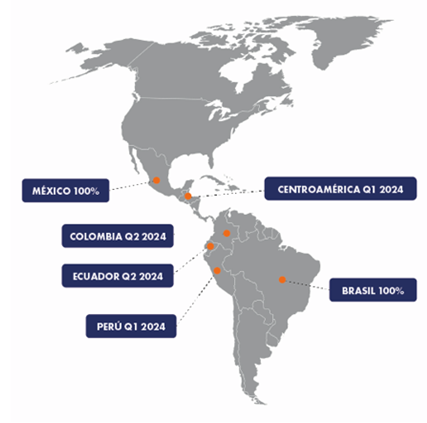
RCS and SMS are messaging platforms with distinct features. While SMS is limited to 160-character text messages without multimedia support, RCS allows for enriched messages that include images, videos, and files. RCS also supports advanced functions like read receipts, suggested replies, and personalized branding, significantly surpassing SMS capabilities.
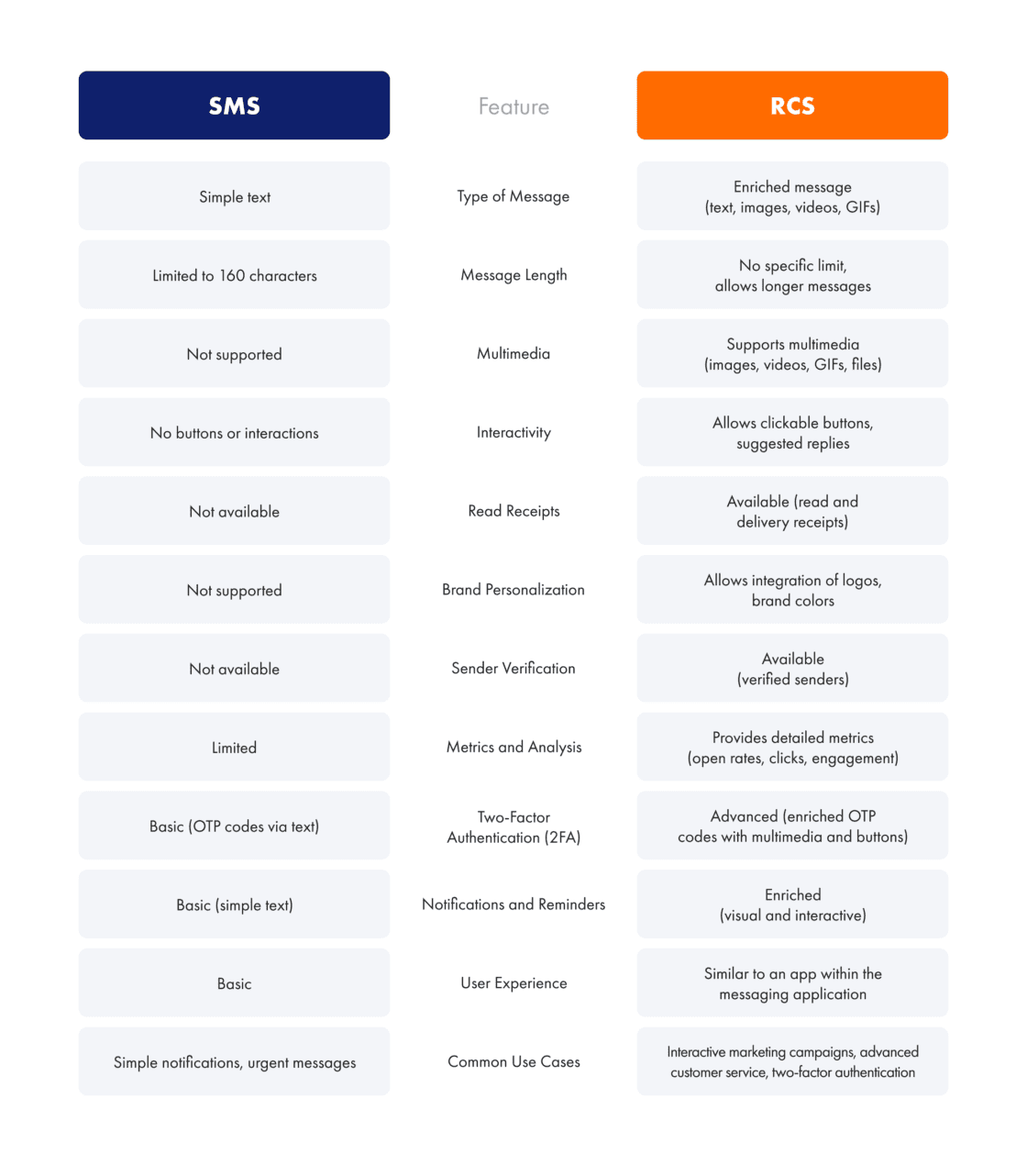
Advantages of RCS over SMS
- Enhanced Interactivity: RCS enables messages with clickable buttons and suggested replies.
- Multimedia Content: Messages can include images, videos, GIFs, and more.
- Personalized Branding: Allows the integration of logos and brand colors in messages.
- Sender Verification: Ensures message authenticity and security.
- Detailed Metrics: Provides data on open rates, clicks, and engagement.
When to Use RCS and When to Use SMS
- RCS: Ideal for interactive marketing campaigns, advanced customer service, enriched notifications, and two-factor authentication.
- SMS: Useful for simple and urgent messages, especially in areas with low internet connectivity or on devices without RCS support.
2. RCS Business Messaging (RBM)
What is RBM?
RCS Business Messaging (RBM) is an advanced evolution of business messaging, combining the rich capabilities of RCS with business-specific functionality. It allows organizations to send interactive and multimedia messages directly to the default messaging apps on their customers’ devices, without the need for additional apps. This creates a more immersive and effective user experience.
Key Features of RBM
- Multimedia Messages: Sending images, videos, GIFs, and audio files.
- Interactivity: Clickable buttons, suggested replies, and content carousels.
- Personalized Branding: Inclusion of logos, brand names, and corporate colors.
- Sender Verification: Authentication and security through verified senders.
- Metrics and Analytics: Details on open rates, clicks, and engagement.
Comparison of RBM with Other Business Messaging Channels
RBM stands out significantly from other messaging channels like SMS, mobile apps, and emails, offering unique advantages:
- SMS: Limited to text and 160 characters. No multimedia or branding capabilities.
- Mobile Apps: Require installation and frequent updates. Less effective notifications.
- Email: High spam rate and lower immediacy compared to instant messaging.
3. Benefits of RCS and RBM for Businesses
Improvement of Customer Experience
RBM allows for richer and more personalized interactions, offering an app-like experience directly in the message inbox. This facilitates customer engagement and satisfaction.
Increase in Conversion Rates and Sales
Thanks to its interactive and multimedia features, RBM significantly increases conversion rates. Action buttons and visually appealing content make it easier for customers to respond and take action, driving sales.
Companies adopting RBM report improved metrics, such as open rates exceeding 80%, click rates up to 40%, and significant increases in conversions and sales. These data demonstrate RBM’s positive impact on communication and marketing strategies.
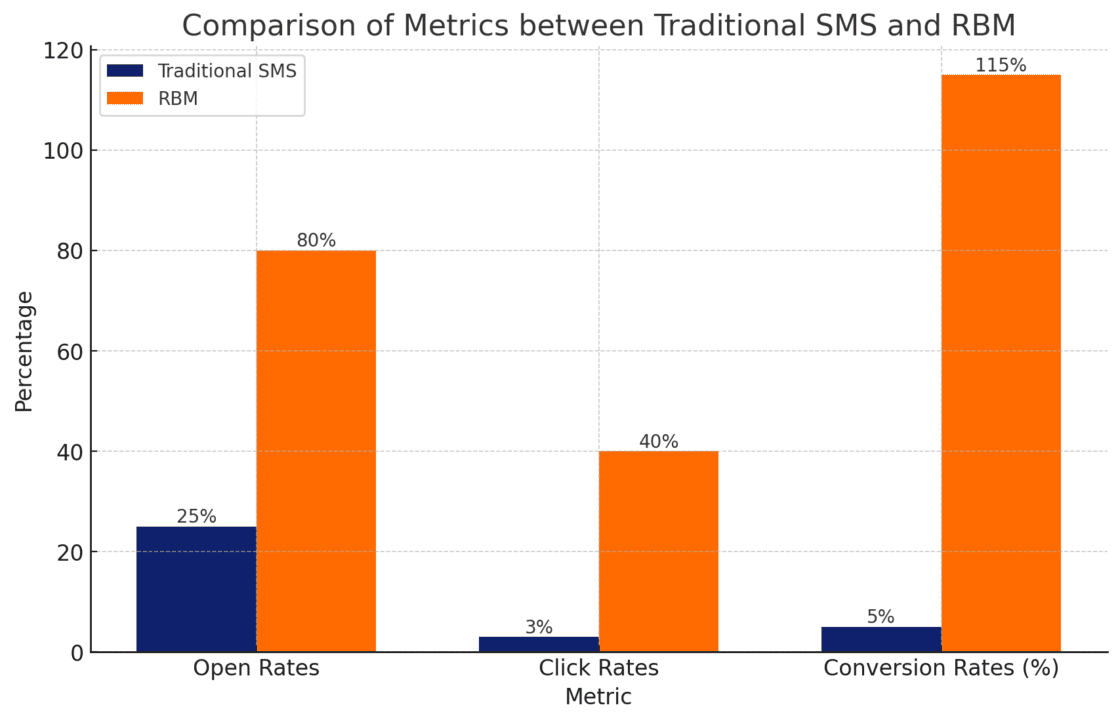
Message Personalization and Branding
RBM allows companies to incorporate branding elements directly into messages, such as logos and corporate colors. This enhances brand recognition and trust, making messages more effective and less likely to be considered spam.

4. Use Cases and Practical Applications
Interactive Marketing
Interactive marketing through RBM allows companies to create more engaging and dynamic campaigns. Using images, videos, and clickable buttons, brands can capture consumer attention and encourage direct interaction. This not only increases engagement but also improves brand perception by offering more personalized and relevant experiences.
Customer Service
RBM transforms customer service by enabling quick and automated responses through chatbots, as well as offering richer and more contextual communication. Companies can send important notifications, resolve common issues, and provide real-time status updates, improving efficiency and customer satisfaction.
Two-Factor Authentication (2FA)
Two-factor authentication (2FA) through RBM provides an additional layer of security with an enhanced user experience. Messages can include OTPs (one-time passwords) with clear instructions and buttons to facilitate authentication. This reduces fraud risk and improves user trust in the security process.
Notifications and Reminders
RBM allows sending enriched and personalized notifications and reminders, such as order updates, appointment reminders, and event alerts. These messages, being more visual and interactive, are more effective in capturing user attention and ensuring critical information is noticed.

Lessons Learned and Best Practices
Successful RBM implementations have provided valuable insights, such as the importance of personalization, the need for a rich content strategy, and integration with other communication channels. Adopting a customer-centric strategy and leveraging the interactive capabilities of RBM are essential practices to maximize its impact.
5. Challenges and Considerations
The adoption of RCS and RBM faces several challenges, such as fragmentation in operator implementation, variability in device support, and the need to educate consumers and businesses on their benefits.
Security and privacy are crucial in implementing RCS and RBM. Although RCS offers sender verification and encryption, companies must ensure their practices comply with data protection regulations and that users trust the platform’s security.
Technological barriers include interoperability between operators and devices, and variability in service quality. Market barriers include operator and manufacturer support and consumer acceptance.
6. Integration of RCS in Latinia
At Latinia, we are committed to innovation and continuous improvement of our communication channels. Soon, we will incorporate RCS (Rich Communication Services) as one of our communication channels, along with Push, SMS, email, and WhatsApp. This integration will allow companies to leverage the advantages of RCS within a unified messaging ecosystem, improving interaction with their customers more effectively and securely.
Benefits of RCS in the Latinia Ecosystem
- Enhanced Interaction: RCS offers a richer and more immersive user experience compared to traditional SMS, allowing multimedia messages, interactive buttons, and chatbots, significantly improving customer interaction.
- Increased Security: Like our other channels, RCS will benefit from Latinia’s robust security measures, ensuring the integrity and confidentiality of communications.
- Unified Ecosystem: The integration of RCS will be based on our LIMSP© architecture, enabling centralized and efficient management of all communication channels. Companies can use a single access point to manage their multichannel communications, obtain detailed statistics, and manage all communication strategies from the Latinia platform.
Technical Features of RCS Integration in Latinia
- Microservices-Based Architecture: The implementation of RCS will be based on our microservices architecture, ensuring the scalability, availability, and easy maintenance of deployed services.
- Real-Time Processing: Using our platform, RCS will be able to process and analyze events in real-time, ensuring timely and relevant notifications.
- Traceability and Audit: Every message sent via RCS will have complete traceability and detailed auditing, ensuring companies can monitor and analyze the effectiveness of their communications.
7. The Future of RCS and RBM
Business messaging is constantly evolving with the growing adoption of RCS and RBM. Emerging trends include the integration of artificial intelligence to enhance personalization and automation, as well as the use of advanced analytics to optimize messaging campaigns. Additionally, increased use of interactive chatbots for customer service and marketing is expected.
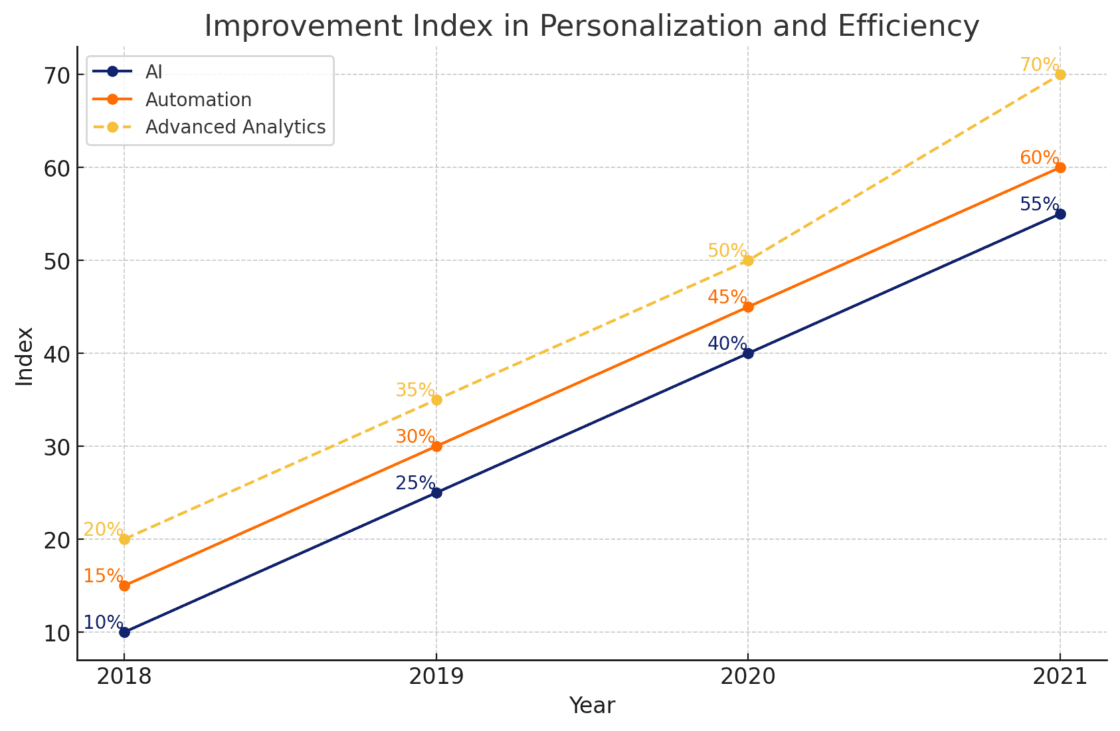
Innovations in RCS and RBM include enhancements in security with advanced encryption and sender verification, as well as the ability to integrate mobile payments directly into messages. Increased interoperability between operators and devices is also expected to ensure a consistent and reliable user experience.
In 2023, the global RCS Business Messaging market was estimated to be worth approximately $10 billion. This value reflects the adoption and support of the technology by operators and manufacturers worldwide. By 2028, the market is projected to reach a value of $22 billion, indicating a significant increase in the adoption and utilization of RCS and RBM by companies across various industries, driven by the growing demand for more interactive and personalized communications with consumers.
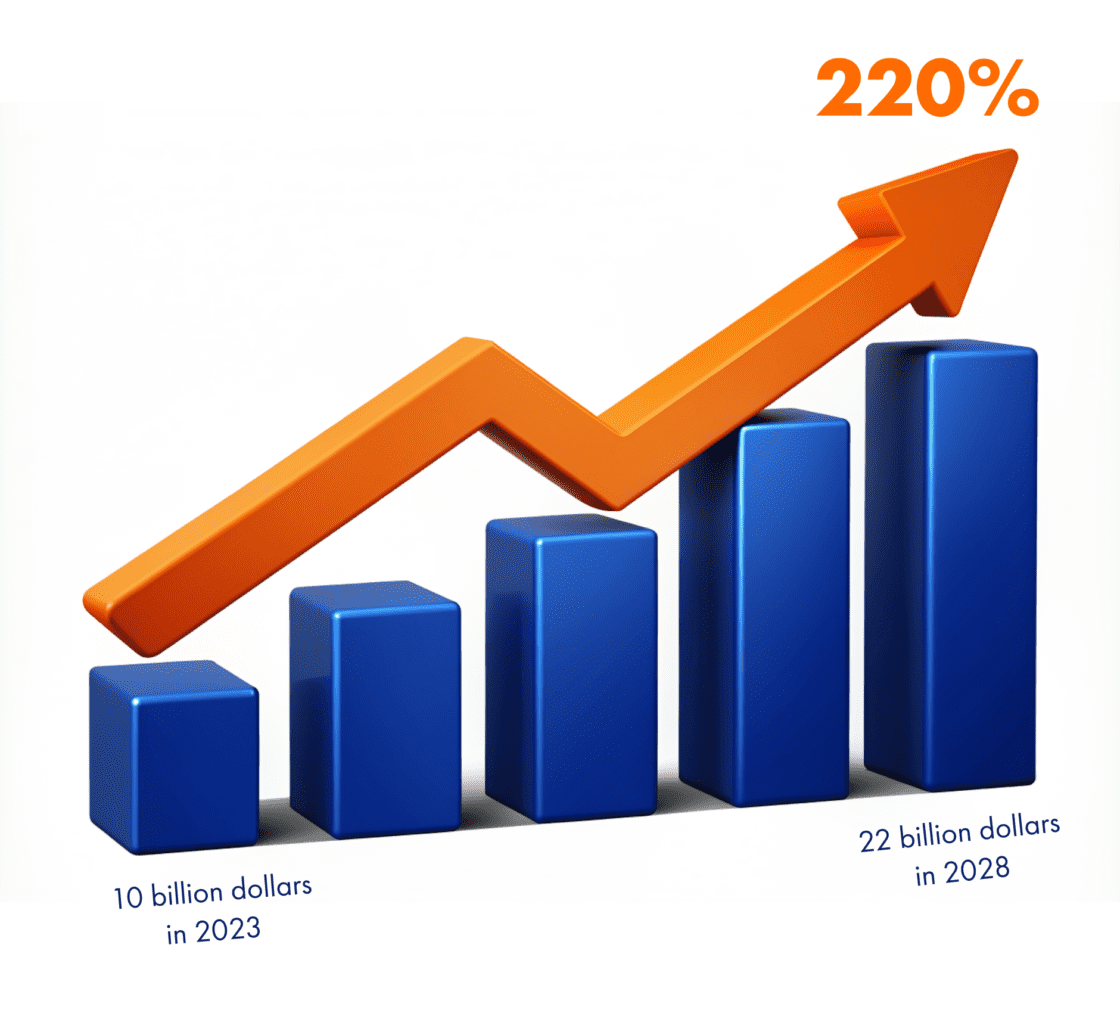
Conclusion
RCS and RBM offer richer, more interactive, and personalized communication compared to traditional SMS. Key benefits include higher open and conversion rates, better branding capabilities, and detailed metrics that allow companies to optimize their communication strategies.
The adoption of RCS and RBM in the banking communication industry can significantly transform customer interactions, providing secure notifications, two-factor authentication, and personalized services. This improves customer satisfaction and strengthens trust in financial institutions.
It is crucial for companies to start adopting RCS and RBM to remain competitive and enhance the customer experience. Implementing these technologies offers unique opportunities to personalize communication, increase efficiency, and gain a market advantage.
With the integration of RCS into our ecosystem, banks will be able to manage all their communications from a single access point, thus optimizing the efficiency and effectiveness of their communication strategies. Additionally, our robust architecture ensures the scalability, availability,

